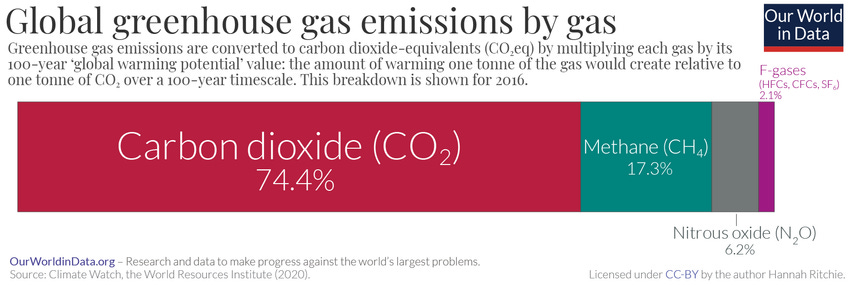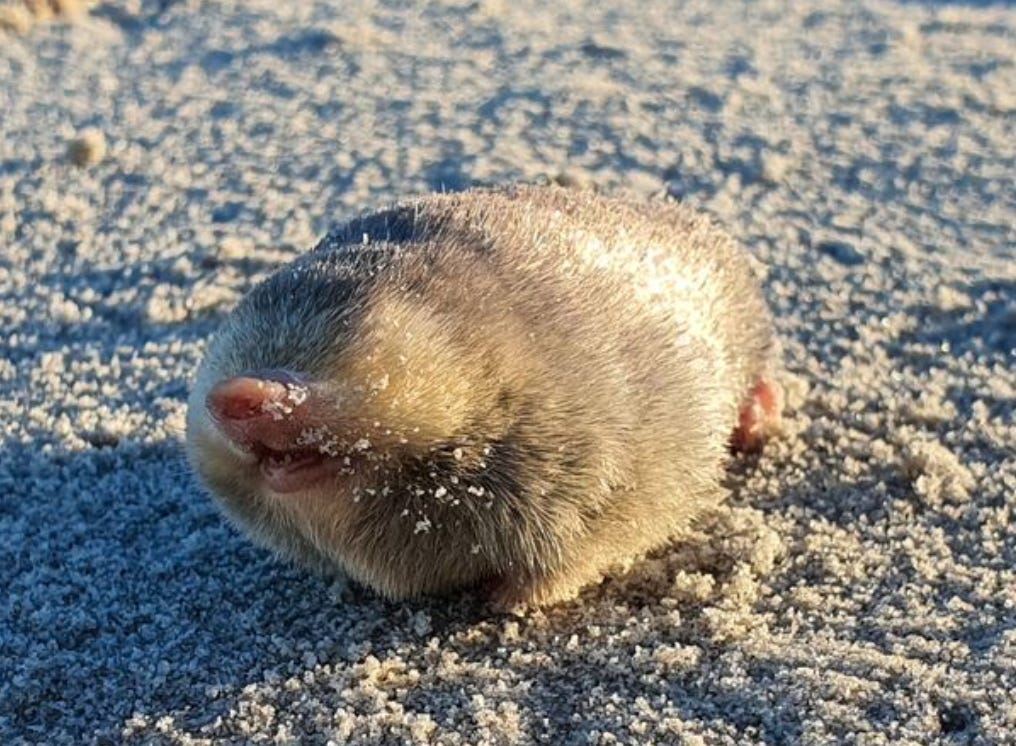The Weekly Anthropocene, December 6 2023
New COP28 commitments to reduce methane emissions, the worldwide rise of farm bots, a rediscovered golden mole, an electric ferry, deepwater coral reefs off the Galápagos, and more!
United Arab Emirates: Climate Talks
Despite multiple scandals around the iniquitous behavior of the host country1, the global COP28 climate talks in Dubai are starting to produce a few useful outcomes. A World Bank-hosted loss and damage fund for victims of climate disasters was agreed to on the first day, with over $400 million pledged so far. 22 countries (including the US, UK, France, and Morocco) made a joint declaration to triple nuclear energy production by 2030. Acrimonious discussions on verbally committing to a “phase down” or “phase out” of fossil fuels are likely to occupy much of the remaining period until the talks end in mid-December, but will likely have limited practical effect. The most immediately impactful outcome of COP28 is probably the new wave of actions to reduce methane emissions. (We’ll shortly have a Deep Dive article giving more background on methane emissions!)
Here’s a précis of what’s been announced on methane at COP28 so far:
Five more nations (Angola, Kazakhstan, Kenya, Romania and Turkmenistan) joined a U.S. and EU led coalition pledging to cut global methane emissions 30% by 2030. Turkmenistan is a disproportionately large methane emitter, so their sign-on is a major win (more analysis on this in our upcoming Deep Dive article).
50 oil companies signed a pledge to reduce methane emissions directly tied to their operations by 90% (…we’ll see how this goes).
An alliance of nonprofits including the Environmental Defense Fund, the International Energy Agency, the United Nations Environment Programme, and Bloomberg Philanthropies launched a joint effort to track methane emissions from the oil and gas sector, making the data publicly available to hold companies and governments accountable. The EDF’s MethaneSAT project should launch a new methane-tracking satellite in 2024.
And, perhaps most notably, the Biden Administration announced at COP28 on December 2, 2023 that the U.S. EPA had finalized a new regulatory rule requiring oil and gas companies to get their act together on plugging methane leaks from fossil fuel wells, pipes, and mines. The new rule should prevent 58 million tons of methane emissions between 2024 and 2038, equivalent to taking 28 million gas cars off the road every year. This one action should eliminate 2% of America’s total greenhouse gas emissions all on its own. The EPA also estimates that the new rule will have substantial public health benefits by preventing the emission of 16 million tons of volatile organic compounds that often leak along with methane. Great news!
“Under President Biden and Vice President Harris’s leadership, the U.S is turbocharging the speed and scale of climate action, at home and abroad, including our collective efforts to tackle super-pollutants like methane.
From mobilizing billions in investment to plug orphaned wells, patch leaky pipes, and reclaim abandoned mines to setting strong standards that will cut pollution from the oil and gas sector, the Biden-Harris Administration is putting the full throw-weight of the federal government into slashing harmful methane pollution.”
-U.S National Climate Advisor Ali Zaidi.
Farm Bots
Around the world, farm robots are emerging as a cool new technology to enhance agriculture, enabled by the modern surge in AI and battery technology. They bring a wide range of positive effects, including increased precision, lower pesticide use, and lower human labor requirements amid the global demographic transition. Here are just a few examples!
In Sweden, the Ekobot uses AI to recognize weeds in fields, then deploys its metal fingers to manually pluck them. It can navigate for 10-12 hours a day on one charge, and can cover 10 hectares a day. In trials, the Ekobot allowed onions to be grown with 70% fewer herbicides. The first onions grown with Ekobot weeding, dubbed “5G onions,” recently became available in Swedish stores, and the Ekobot will soon be rolled out in carrot and beet fields in Sweden as well as other enterprises in Denmark, Norway, and the Netherlands. It should be available across the U.S. and UK by 2030!
“The 5G onion is not only more sustainable—it also tastes better. This is because efficient weeding and reduced use of pesticides enables onion shoots to grow more freely and for longer, enabling the onions to receive more sunlight and nutrients, making them more hardy and tasty."
Israeli startup Tevel has developed a system of apple-harvesting robots composed of autonomous drones that collect data on every apple they pick, then deposit them in the wagons they’re tethered to. Tevel has now partnered with Unifrutti, one of the world’s major fruit companies, to bring their apple-picking drones to orchards in Chile.
Brazilian startup Solinftec is currently selling a $50,000 solar-powered farm bot that can monitor individual crops and zap pest insects with electric shocks.
Farm bots are also becoming common in Japan, especially in large-scale greenhouses, and Japanese company Inaho has already leased a cherry tomato-picking robot to the Netherlands.
Several open-source farm robot designs are also being iterated, from FarmBot to The Acorn, alongside many other startups around the world.
Overall, there’s a lot of amazing potential in this field! A world where widespread farm bots produce better food in a more environmentally friendly way with less need for humans to do backbreaking work truly would be a good Anthropocene.
South Africa
The rare De Winton’s golden mole hadn’t been seen since 1936, and in recent years this blind sand-tunneler was added to an international “most wanted” list of 25 “lost species.” Now, a research team has rediscovered this golden mole in the deserts around Port Nolloth, South Africa, with the help of a mole-sniffing border collie named Jessie and cutting-edge “eDNA” analysis that can identify species from stray skin cells and hair found in sand samples. This is the 11th of the 25 “lost species” to be rediscovered! Great news.
Singapore
The government of Singapore has announced that they’re starting technical studies and public consultation on a vast new land reclamation and coastal resilience project, dubbed “Long Island,” which would reclaim land and build new tidal gates and pumping stations to protect Singapore’s East Coast area from sea level rise. The project could also create 20 kilometers of new waterfront parks.
Ecuador
Researchers have used a remotely operated submersible drone to discover two new deepwater coral reefs in the waters around Ecuador’s Galápagos Islands. One is over 800 meters long and the other is 250 meters long, and both are home to Madrepora stony coral species and found between 370 and 420 meters below sea level. The reefs may be thousands of years old.
Sweden
Fresh off banning non-EV cars from the city center, the Swedish capital of Stockholm will be setting a new electrification example in July 2024 when it starts running a Candela P-12 electric ferry on a local passenger route. On carbon-fiber hydrofoil wings, this electric ferry leaves no wake and can reach a speed of up to 30 knots (56 kilometers per hour). Great work!
Kosovo
The 12,000-panel Rogane solar farm in the small Balkan nation of Kosovo has brought in a herd of sheep to keep the grass around the panels low. This is a very small development compared to the giant global explosion of solar build-outs this year, but the striking photo is a great reminder of the rapidly growing potential for agrivoltaics: we can easily have farms that produce clean electrons and food (or wool) at the same time!
United States

As previously reported in this newsletter, Fervo Energy is making grid-scale enhanced geothermal power generation a reality, pulling off a successful commercial-scale test in Nevada in July 2023 and starting drilling in September 2023 for a 400-MW facility in Utah set to be complete by 2028. (Enhanced geothermal works by essentially making its own underground hot water deposits, injecting water far enough underground that it heats up, then letting that hot water rise back up another drilled well to turn a turbine to produce electricity).
Now, Fervo has connected its Google-funded 3.5-MW Nevada test site to the grid, providing clean electrons for the local utility. Another big step in the dawn of enhanced geothermal! Great work.
A new federal analysis from Lawrence Berkeley National Laboratory has found that the underground brines of California’s Salton Sea contain sufficient lithium for 375 million EV batteries—enough to meet the nation’s needs for decades! A combined lithium extraction/geothermal power project is already in the works. This is going to be a really awesome component of America’s clean energy future!
EVs are on track to make up 9% of new light-duty vehicle sales in the U.S. in 2023, up from 7.9% in 2022.
22 cities in California are experimenting with AI-powered instant permitting, using software that essentially automates the legal process of approving solar developments. This is great, and hopefully scales nationwide! Outflanking NIMBYism and permitting barriers could be a vital new use for AI.
A startup in Ohio is building park benches out of old wind turbine blades.
24 U.S. states are about to produce climate action plans for the first time, thanks to the Climate Pollution Reduction Grants, an Inflation Reduction Act program.
The Biden Administration EPA announced proposed regulatory improvements that would require water systems to replace their lead service lines within 10 years, part of a wide range of recent actions to address brain-damaging lead pollution.
Michigan is now home to America’s first stretch of road that can charge EVs while driving on it. A quarter-mile stretch of Detroit’s 14th Street is testing startup Electreon’s wireless road charging technology.
Virtual power plants, software-linked networks of home renewable energy systems coordinated to act together to meet grid demand, are blossoming across America. As Bill McKibben notes, a virtual power plant comprising 4,500 batteries (mostly Tesla Powerwalls) across 3,000 homes is now the single largest energy producer in Vermont!











Outstanding issue! No one on Substack is performing the valuable service you are- providing us a one-stop compendium of antidotes to the dispair that haunts our times.
My only wish is that you could construct your newsletters so that we readers could submit comments after subgroups of the features. There's just too many of them for an old guy like me to remember at the end! But here goes.
COP and methane -great! ⭐⭐⭐⭐⭐. High time too. I worried more about methane than I did about carbon! Now what do we do about that subsea and circumpolar methane release going on from our permafrost? They should start working on it!
Ekobots: ⭐⭐⭐⭐⭐ great news. The Europeans really have their act together and with that ferry too!
Golden Mole: Super Great! ⭐⭐⭐⭐⭐++ Don't ask me why the enthusiasm, but this one really makes me happy. Viva golden moles (and all desert species for that matter!)
U.S. palliative and restorative measures: ⭐⭐⭐⭐⭐ for good intentions! We're finally getting the political will to do something! But ⭐⭐⭐ for durability. It's the U.S. after all and what arm gives out, the other arm snatched away. Blasted politics!!
Now I forgot the rest except corals Yay. Singapore Yay. South American initiatives Yay yay and yay!
Can't wait for the next issue!